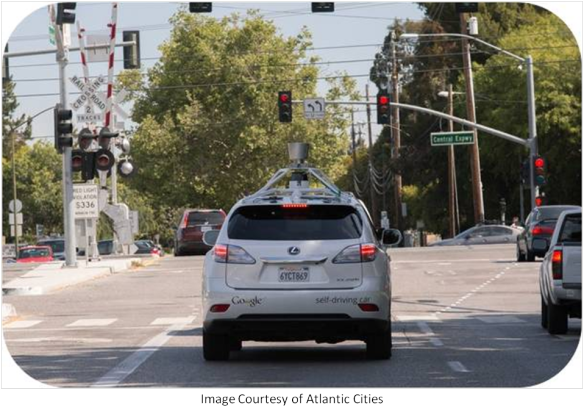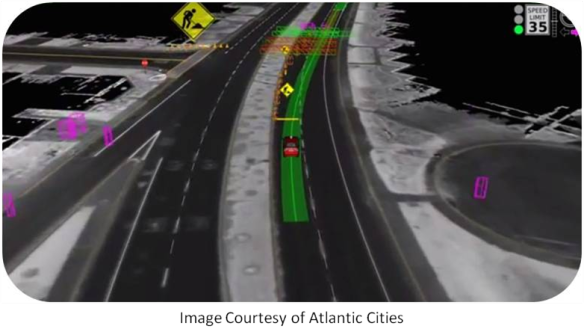Last month (March 2014), NHTSA submitted the final rule requiring more stringent rear-visibility standards in light vehicles. This rule is the end result of a process that began in 2007, when Congress passed the Kids Transportation Safety Act. By reviewing this rule, I’ve learned some things about NHTSA’s role as a regulatory agency, and how the regulatory process may influence connected cars.
Let’s talk first about connected cars. When NHTSA and the U.S. DOT talk about “connected vehicles,” they aren’t referring generally to any kind of cellular, Wi-Fi, satellite or other commercialized connectivity options. NHTSA’s connected vehicle program focuses specifically on Wi-Fi-like standard known as dedicated short-range communications, or DSRC. The U.S. DOT and many other organizations have been cooperatively developing DSRC for a standardized connected vehicle network using a chunk of spectrum in the 5.9 GHz band—which has been set aside by the FCC for government use, including connected vehicles and other Intelligent Transportation Systems (ITS).
The DSRC technology itself is relatively mature and may be useful today for a variety of applications. However, it is widely believed within the industry that for DSRC to be adopted into consumer vehicles, NHTSA will have to mandate DSRC connectivity as a requirement. NHTSA has recently announced via press release an intent to “move forward” on connected vehicle regulation, but has yet to officially begin the regulatory process by publishing in the Federal Register.
Reviewing NHTSA’s new rear visibility rule highlighted the fact that NHTSA’s regulatory power mainly concerns safety. (NHTSA is also authorized to administer Corporate Average Fuel Economy [CAFE] standards, but this power is from a specific act of Congress.) Generally, federal regulations allow NHTSA only to adopt rules that pertain specifically to vehicle safety. Furthermore, NHTSA may only adopt rules that pass cost-benefit analysis (i.e., the cost of a mandate must result in a greater or equal benefit in the monetary equivalent of lives saved and injuries prevented).
NHTSA actually was unable to show that its new rear visibility rule passes cost-benefit requirements. However, NHTSA didn’t have to, because they were specifically required by the K.T. Safety Act to adopt a rule that amends the Federal Motor Vehicle Safety Standards (FMVSS) to increase the field of view behind a vehicle. So in this case, NHTSA only had to show that the adopted rule meets the requirements of the act in the most effective and cost-effective way. In the discussion surrounding the final rule, NHTSA commented that it believes that the rule will also result in significant non-safety benefits. However, it cannot consider these in formal cost-benefit analysis, because its regulatory authority concerns safety.
I can’t see how a DSRC connected vehicle mandate will pass cost-benefit analysis. The U.S. DOT and others often throw out ‘facts’ like, “95% of all crashes are caused by human error;” the implication being that connected vehicles will prevent these crashes. I’ve never seen the idea that connected vehicles will prevent any number of crashes to be sufficiently supported.
We should take note that NHTSA is currently only considering mandating vehicle communication devices, not any kind of automated safety devices. Most of the research I have seen suggests that safety features that provide driver feedback are nearly useless unless accompanied by automated safety systems. Even NHTSA’s new rear visibility rule is anticipated to prevent only about 1/3rd of backover crashes. Some commenters on the rule mentioned that automated systems might be more effective. NHTSA responded that, basically, that might be true but they didn’t know enough about those systems and anyway they were required by Congress to increase the field of view behind a vehicle.
NHTSA is currently analyzing data from a Connected Vehicle Safety Pilot Deployment study in Ann Arbor, MI. (Full disclosure, I volunteered as a subject and have a DSRC transmitter in my car.) In order for NHTSA to propose a rule, they are going to have to find a way to argue that DSRC communications will save more lives than it would cost to impose a mandate. I am looking forward to seeing what they come up with.
Eric Paul Dennis, Center for Automotive Research (CAR)
Follow Eric on Twitter: @EricPaulDennis



